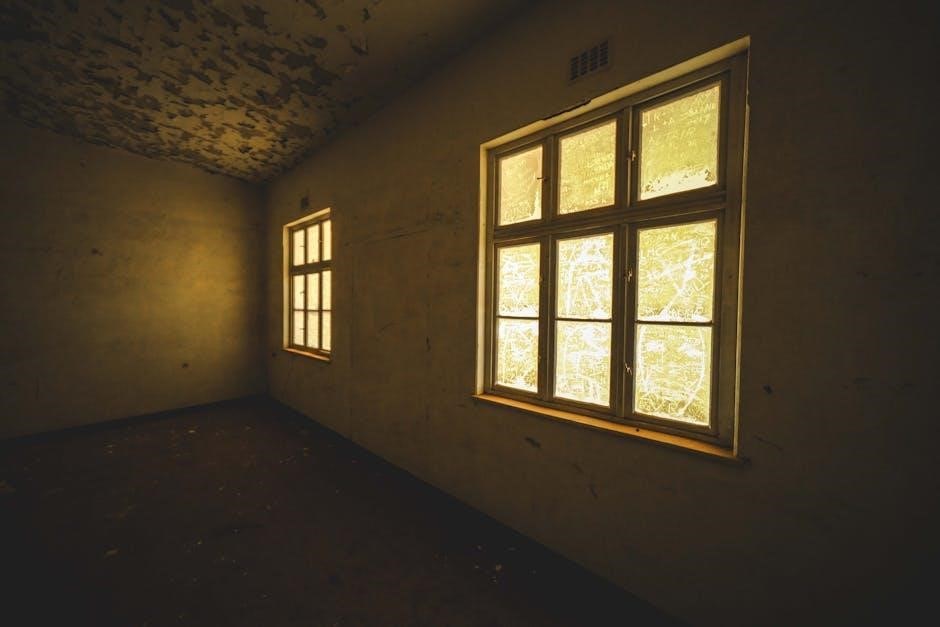James Baldwin’s Giovanni’s Room is a powerful exploration of desire, identity, and morality set in 1950s Paris, capturing the complexities of human relationships and societal expectations.
1.1 Overview of the Novel
Giovanni’s Room by James Baldwin is a profound and deeply emotional novel set in 1950s Paris. The story follows an American expatriate grappling with his desires and societal expectations, exploring themes of sexuality, identity, and morality. The narrative delves into the complexities of human relationships and the internal conflicts of its protagonist, offering a poignant examination of love, isolation, and self-discovery. Written with Baldwin’s characteristic lyrical prose, the novel captures the tension between personal freedom and the constraints of cultural norms. Its vivid portrayal of Parisian life and the emotional depth of its characters have made it a landmark work in LGBTQ+ literature, resonating with readers for its universal themes and unflinching honesty.
1.2 Historical Context of the Book
Giovanni’s Room is set against the backdrop of 1950s Paris, a city that attracted American expatriates seeking liberation from the rigid societal norms of post-war America. This period was marked by heightened tensions around race, sexuality, and identity, themes that Baldwin explores with unflinching candor. The novel reflects Baldwin’s own experiences as a Black American in France, where he found temporary refuge from racial discrimination but still grappled with homophobia and isolation. The historical context of the time, including the conservative moral standards of the era, deeply influenced the narrative, which portrays a world where love and desire were often stifled by societal expectations. This setting allows Baldwin to examine universal human struggles within a specific historical framework, making the novel both a product of its time and timeless in its relevance.

Themes in “Giovanni’s Room”
Explores themes of identity, desire, and racial tensions, reflecting Baldwin’s profound insight into human complexity and societal norms.
2.1 Sexuality and Identity
Giovanni’s Room delves deeply into themes of sexuality and identity, particularly through the protagonist David’s internal conflict with his desires. Set against the backdrop of 1950s Paris, the novel explores the tension between societal expectations and personal truth. David’s relationship with Giovanni, an Italian barman, challenges his conventional understanding of himself, forcing him to confront his repressed feelings. This struggle reflects broader societal norms of the time, where same-sex relationships were often hidden and stigmatized. Baldwin’s masterful portrayal of David’s emotional turmoil and Giovanni’s unapologetic embrace of his identity offers a poignant examination of self-discovery and the complexities of human sexuality.
2.2 Race and Colonialism
Baldwin interweaves race and colonialism into the fabric of Giovanni’s Room, reflecting his own experiences as a Black American expatriate in France. The novel subtly critiques the power dynamics rooted in colonial histories, particularly through the interactions between American and European characters. Baldwin’s portrayal of Parisian society highlights the lingering effects of colonialism, where marginalized groups seek escape and identity in a foreign land. The characters’ struggles with race and identity are mirrored in their personal relationships, revealing the deep-seated tensions of post-war Europe. This subtext enriches the narrative, offering a layered exploration of how race and colonialism shape individual and collective experiences.
Key Characters in the Novel
Giovanni’s Room centers around David, a young American grappling with his sexuality, and Giovanni, an Italian bartender whose tragic fate shapes the narrative. Their complex relationship explores themes of love, identity, and isolation in 1950s Paris.
3.1 David and His Inner Conflict
David, the protagonist of Giovanni’s Room, is a young American expatriate in 1950s Paris, torn between his desires and societal expectations. His inner conflict revolves around his repressed sexuality and the fear of embracing his true self. As he navigates his relationship with Giovanni, David struggles with guilt and identity, reflecting the broader societal norms of the time. His journey is marked by self-doubt and the internalized homophobia prevalent in the era, making him a deeply complex and relatable character. Through his story, Baldwin masterfully portrays the anguish of living a life unauthentic to oneself, resonating with readers seeking understanding and acceptance.
3.2 Giovanni: The Tragic Hero
Giovanni, the titular character of Baldwin’s novel, embodies the essence of a tragic hero, whose fate is sealed by the societal norms and prejudices of his time. His passionate and unapologetic nature contrasts sharply with David’s internalized repression, making him a symbol of authenticity and doomed love. Giovanni’s downfall is both inevitable and heart-wrenching, as he faces betrayal, rejection, and ultimately, a tragic end. Through his character, Baldwin explores themes of marginalization, identity, and the devastating consequences of unaccepted love. Giovanni’s story serves as a poignant reminder of the sacrifices made by those who dare to be true to themselves in a world that refuses to accept them. His legacy in the novel is one of profound emotional depth and enduring tragedy.

Plot Summary of “Giovanni’s Room”
Set in 1950s Paris, the novel follows David, an American expatriate, as he navigates a tumultuous affair with Giovanni, an Italian bartender, leading to a tragic confrontation of desire, identity, and societal expectations.
4.1 The Setting: 1950s Paris
The novel is set in Paris during the 1950s, a city that serves as a refuge for American expatriates seeking escape from societal constraints. This post-war era is marked by a vibrant yet tense atmosphere, where cultural and moral boundaries are tested. Paris, with its rich history and artistic vibe, becomes a backdrop for exploring themes of identity, desire, and alienation. The city’s expatriate community, including bars and cafes, provides a space for characters like David and Giovanni to navigate their complex relationships. The setting also reflects the moral hypocrisy of the time, as characters grapple with their own identities amidst societal expectations. The Parisian environment, with its blend of beauty and isolation, plays a crucial role in shaping the novel’s emotional and psychological landscape.
4.2 The Tragic Love Story
At the heart of Giovanni’s Room lies a poignant and doomed love story between David, an American expatriate, and Giovanni, an Italian bartender in Paris. Their relationship, marked by passion and vulnerability, unfolds against the backdrop of societal norms and personal insecurities. David’s internal conflict between his desire for Giovanni and his adherence to conventional morality drives the narrative. Meanwhile, Giovanni’s openness and sincerity contrast with David’s ambivalence, deepening the emotional tension. The story’s tragic trajectory is sealed when their love becomes untenable, leading to devastating consequences. Baldwin masterfully portrays the complexity of human emotions, highlighting the destructive power of fear, repression, and the pursuit of acceptance. This tale of star-crossed lovers remains a powerful exploration of love’s fragility and societal constraints.

Symbolism in the Novel
The room symbolizes isolation and entrapment, while the guillotine represents impending doom, reflecting the characters’ emotional and societal struggles in a world of rigid expectations.
5.1 The Room as a Symbol of Isolation
In Giovanni’s Room, the room serves as a potent symbol of isolation, trapping the characters in a space of emotional and physical confinement. It represents the societal constraints that force individuals to hide their true selves, particularly their sexuality. For David and Giovanni, the room becomes a refuge and a prison, reflecting their inner turmoil and fear of judgment. The confined space mirrors their emotional detachment from the world outside, emphasizing their alienation. Baldwin uses the room to illustrate the consequences of internalized shame and the struggle for self-acceptance in a hostile environment. This isolated setting underscores the novel’s themes of loneliness and the devastating effects of societal expectations on personal identity.
5.2 The Significance of the Guillotine
The guillotine in Giovanni’s Room serves as a haunting symbol of execution and societal judgment, foreshadowing Giovanni’s tragic fate. It represents the brutal consequences of societal norms and the destruction of authenticity. The guillotine embodies the violence inflicted on those who defy conventional morality, particularly in relation to sexuality and identity. Its presence underscores the novel’s exploration of themes such as alienation, repression, and the devastating costs of societal expectations. Baldwin uses the guillotine to highlight the ways in which individuals are “executed” emotionally and psychologically for their nonconformity. This powerful imagery reinforces the novel’s critique of a world that rejects those who cannot conform to its rigid standards, leaving them isolated and doomed.

PDF Availability and Download Options
Giovanni’s Room is available as a downloadable PDF from various sources, including authorized platforms like ZeroTimeLibrary and Internet Archive, ensuring legal and easy access to Baldwin’s timeless work.
6.1 Authorized Sources for Download
Authorized sources for downloading Giovanni’s Room in PDF format include reputable platforms like ZeroTimeLibrary and Internet Archive. These sites offer legal access to the novel, ensuring readers can enjoy Baldwin’s work without infringing on copyright laws. Additionally, some publishers provide free PDF downloads as part of their inclusivity initiatives, making the book accessible to a broader audience. It’s important to verify the authenticity of the source to avoid unauthorized versions, which may violate intellectual property rights. Always opt for trusted platforms to support authors and publishers while gaining access to high-quality digital content.
6.2 Free PDF Downloads and Their Legality
Free PDF downloads of Giovanni’s Room are widely available online, but their legality varies. While some sites offer the novel for free under public domain or creative commons licenses, others may distribute it without authorization, infringing on copyright laws. Publishers and authors often face financial losses due to unauthorized sharing. However, platforms like Internet Archive and educational institutions may legally provide free access to promote literacy and education. Users should always verify the legitimacy of the source to avoid legal issues and support the creators. Free downloads can be a valuable resource when obtained ethically, ensuring both accessibility and respect for intellectual property rights.

Reception and Reviews of the Novel
Giovanni’s Room received critical acclaim for its emotional depth and lyrical prose, becoming a groundbreaking work in LGBTQ+ literature. Its exploration of universal themes continues to resonate.
7.1 Critical Acclaim and Controversies
Giovanni’s Room garnered significant critical acclaim for its unflinching portrayal of same-sex relationships and its lyrical prose. Critics praised Baldwin’s ability to weave a deeply emotional narrative, exploring themes of identity, desire, and societal constraints. The novel’s vivid imagery and moral complexity resonated with readers, establishing it as a landmark in LGBTQ+ literature. However, its explicit content and frank discussion of homosexuality led to controversy, particularly in the conservative 1950s. Some publishers initially rejected the manuscript, fearing backlash. Despite this, the novel’s raw honesty and emotional depth solidified Baldwin’s reputation as a fearless and visionary writer. Its enduring relevance continues to spark both admiration and debate, highlighting its importance in literary history.
7.2 Modern-Day Relevance of the Book
Giovanni’s Room remains a poignant and timely work in contemporary discussions of identity, sexuality, and social justice. Its exploration of internalized homophobia, racial tensions, and existential crises resonates deeply with modern readers. The novel’s themes of isolation and self-discovery are universal, transcending time and cultural boundaries. Baldwin’s critique of societal norms and his compassionate portrayal of marginalized characters continue to inspire conversations about equality and human rights. The book’s influence is evident in LGBTQ+ literature and activism, making it a cornerstone of queer narratives. Its relevance endures as a powerful reminder of the ongoing struggle for acceptance and the importance of authentic self-expression in a world often resistant to change.

Adaptations and Interpretations
The novel has inspired theatrical adaptations, with Quintessence Theatre producing the first estate-sanctioned version, highlighting its enduring relevance. Its influence on LGBTQ+ literature remains profound.
8.1 Theatrical Adaptations of “Giovanni’s Room”
James Baldwin’s Giovanni’s Room has been adapted into a theatrical production by Quintessence Theatre, marking the first authorized adaptation sanctioned by Baldwin’s estate. This groundbreaking play premiered at the Sedgwick Theater in Germantown, Philadelphia, bringing the novel’s intense emotional landscape to the stage. Directed by Alexander Burns, the production captures the complex dynamics between David and Giovanni, emphasizing themes of desire, identity, and societal judgment. The adaptation stays true to Baldwin’s original narrative while offering a fresh interpretation of the characters’ struggles. This theatrical rendition has been praised for its ability to translate the novel’s lyrical prose into a visually and emotionally compelling performance, resonating deeply with audiences familiar with the book. It underscores the enduring relevance of Baldwin’s work in exploring human relationships and societal norms.
8.2 The Novel’s Influence on LGBTQ+ Literature
Giovanni’s Room has become a seminal work in LGBTQ+ literature, offering an unflinching portrayal of same-sex relationships and internalized homophobia. Published in 1956, the novel broke ground by centering queer characters and experiences, challenging the era’s oppressive norms. Its frank exploration of desire and identity has inspired countless authors, including prominent LGBTQ+ writers like Edmund White and Ocean Vuong. The novel’s influence extends beyond literature, contributing to broader cultural conversations about queerness and visibility. Its legacy endures as a powerful testament to the struggles and resilience of LGBTQ+ individuals, cementing its place as a cornerstone of queer literary history. Baldwin’s work continues to resonate, offering timeless insights into the human condition and the fight for acceptance.

James Baldwin’s Writing Style
Baldwin’s prose is lyrical and intense, blending poetic imagery with unflinching honesty. His narrative technique masterfully explores complex emotions, creating deeply human characters and moral dilemmas. His writing captivates readers with its emotional depth and vivid storytelling, making Giovanni’s Room a timeless literary masterpiece that continues to resonate with audiences today.
9.1 Prose and Narrative Technique
James Baldwin’s prose in Giovanni’s Room is renowned for its poetic imagery and emotional intensity. His narrative technique masterfully weaves vivid descriptions of setting and character, creating a deeply immersive experience. Baldwin’s use of language is both evocative and precise, capturing the inner turmoil of his characters with unflinching honesty. The novel’s non-linear structure adds complexity, reflecting the fragmented nature of David’s psyche. Baldwin’s ability to balance lyrical prose with raw emotional depth underscores the novel’s exploration of identity, desire, and moral ambiguity. His writing style, both elegant and powerful, draws readers into the intimate and often painful world of his characters, making Giovanni’s Room a landmark of 20th-century literature. His narrative approach continues to inspire writers and captivate readers with its timeless relevance.
9.2 The Use of Language and Imagery
James Baldwin’s use of language in Giovanni’s Room is both profound and evocative, employing rich imagery to convey the emotional and psychological depth of his characters. His vivid descriptions of Parisian settings and the muted tones of Giovanni’s room create a stark contrast, symbolizing the internal and external conflicts faced by the characters. Baldwin’s imagery often carries a dual meaning, reflecting the duality of identity and desire that permeates the novel. His language is both poetic and raw, capturing the intensity of human emotions while maintaining a lyrical quality. This masterful use of imagery not only enhances the narrative but also underscores the themes of isolation, love, and self-discovery, making the novel a deeply resonant and visually compelling work of literature. Baldwin’s imagery remains a testament to his skill as a storyteller and his ability to evoke powerful emotions through language.
Cultural and Social Impact
Giovanni’s Room has profoundly shaped queer narratives, offering a raw portrayal of LGBTQ+ experiences and challenging societal norms, leaving a lasting impact on American and global literature.
10.1 The Novel’s Role in Shaping Queer Narratives
Giovanni’s Room played a pivotal role in shaping queer narratives by offering an unflinching portrayal of same-sex relationships and identity struggles during a time of deep societal repression. James Baldwin’s courageous exploration of homosexuality in the 1950s provided a voice to marginalized communities, challenging both racial and sexual norms; The novel’s raw honesty and emotional depth helped pave the way for future LGBTQ+ literature, breaking ground for more open and authentic storytelling. Its influence can be seen in many modern queer narratives, affirming its status as a landmark work in the genre. The book remains a powerful symbol of resistance and self-expression, continuing to resonate with readers today.

10.2 Baldwin’s Contribution to American Literature
James Baldwin’s contributions to American literature are profound and far-reaching. Through works like Giovanni’s Room, he challenged racial, sexual, and social norms, offering unflinching critiques of American society. His prose, both poetic and incisive, explored themes of identity, morality, and the human condition, resonating deeply with diverse audiences. Baldwin’s writing not only enriched the literary canon but also provided a voice for marginalized communities, bridging gaps between race, sexuality, and culture. His influence extends beyond literature, impacting social movements and cultural discourse. Today, Baldwin is celebrated as one of the most important American writers of the 20th century, his works continuing to inspire and provoke new generations of readers and writers alike.

Historical Background of the Author
James Baldwin, a pivotal American writer, faced racial and sexual discrimination early in life, leading him to seek refuge in France, where he penned Giovanni’s Room, reflecting his struggles and artistic genius.
11.1 James Baldwin’s Early Life and Struggles
James Baldwin was born in 1924 in Harlem, New York, to a poor African American family. His early life was marked by hardship and racial discrimination, which deeply influenced his writing. Baldwin’s relationship with his stepfather, a strict Pentecostal minister, was fraught with tension, contributing to his feelings of alienation. He found solace in literature and religion, becoming a teenage preacher before eventually rejecting the church. Baldwin’s struggles with racism and his emerging sexuality led him to leave the U.S. in 1948 for France, where he hoped to escape the oppressive societal norms and focus on his craft. This period of exile became pivotal, shaping his perspective and inspiring works like Giovanni’s Room, which reflects his experiences with identity and alienation.
11.2 Baldwin’s Exile in France and Its Influence on the Novel
James Baldwin’s exile in France, beginning in 1948, profoundly shaped his literary voice and the creation of Giovanni’s Room. Seeking refuge from America’s racism and homophobia, Baldwin found relative freedom in Paris, where he could openly explore his sexuality and identity. The city’s expatriate community provided a backdrop for the novel’s themes of alienation and moral conflict. Baldwin’s experiences in France influenced the setting and characters of Giovanni’s Room, particularly the protagonist’s struggle between conventional morality and desire. The novel reflects Baldwin’s own journey of self-discovery, blending personal and cultural tensions into a poignant narrative. This period of exile became a catalyst for his unflinching examination of human complexity, solidifying his place as a groundbreaking literary figure.
Giovanni’s Room remains a timeless exploration of identity, race, and sexuality, offering profound insights into the human condition. Its emotional depth and relevance continue to resonate deeply today.
12.1 The Lasting Legacy of “Giovanni’s Room”
Giovanni’s Room has left an indelible mark on literature, particularly in LGBTQ+ narratives. Its unflinching portrayal of same-sex relationships and identity struggles paved the way for queer literature. The novel’s emotional honesty and vivid prose have made it a classic, resonating with readers across generations. Its exploration of race, colonialism, and societal norms continues to spark important conversations. As a result, Giovanni’s Room is not only a landmark in Baldwin’s career but also a foundational text in the broader canon of American literature, ensuring its relevance and impact endure.
12.2 Why the Novel Remains Relevant Today
Giovanni’s Room remains relevant today due to its timeless themes of identity, love, and societal oppression. The novel’s exploration of human complexity resonates deeply in contemporary discussions on sexuality and race. Its vivid portrayal of internal conflict and the struggle for acceptance continues to mirror modern experiences, making it a powerful tool for understanding queer identity. Additionally, the novel’s critique of colonialism and moral hypocrisy aligns with current social justice movements. Baldwin’s prose and imagery ensure the story’s emotional depth, keeping it a vital read in today’s diverse literary landscape. Its influence is evident in both theatrical adaptations and its lasting impact on LGBTQ+ literature, solidifying its place as a modern classic.



